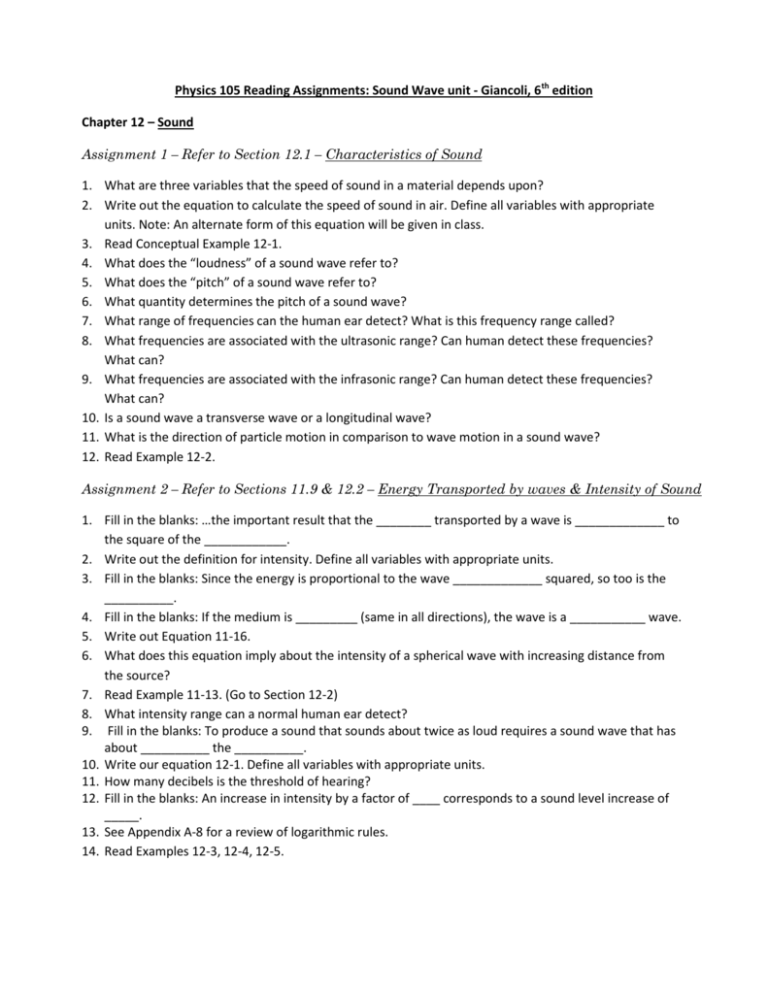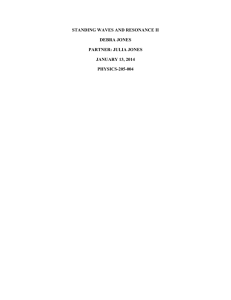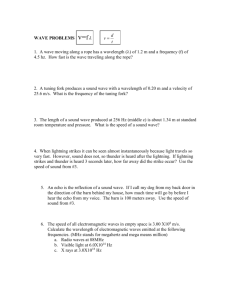Physics Sound Waves Reading Assignment - Giancoli
advertisement

Physics 105 Reading Assignments: Sound Wave unit - Giancoli, 6th edition Chapter 12 – Sound Assignment 1 – Refer to Section 12.1 – Characteristics of Sound 1. What are three variables that the speed of sound in a material depends upon? 2. Write out the equation to calculate the speed of sound in air. Define all variables with appropriate units. Note: An alternate form of this equation will be given in class. 3. Read Conceptual Example 12-1. 4. What does the “loudness” of a sound wave refer to? 5. What does the “pitch” of a sound wave refer to? 6. What quantity determines the pitch of a sound wave? 7. What range of frequencies can the human ear detect? What is this frequency range called? 8. What frequencies are associated with the ultrasonic range? Can human detect these frequencies? What can? 9. What frequencies are associated with the infrasonic range? Can human detect these frequencies? What can? 10. Is a sound wave a transverse wave or a longitudinal wave? 11. What is the direction of particle motion in comparison to wave motion in a sound wave? 12. Read Example 12-2. Assignment 2 – Refer to Sections 11.9 & 12.2 – Energy Transported by waves & Intensity of Sound 1. Fill in the blanks: …the important result that the ________ transported by a wave is _____________ to the square of the ____________. 2. Write out the definition for intensity. Define all variables with appropriate units. 3. Fill in the blanks: Since the energy is proportional to the wave _____________ squared, so too is the __________. 4. Fill in the blanks: If the medium is _________ (same in all directions), the wave is a ___________ wave. 5. Write out Equation 11-16. 6. What does this equation imply about the intensity of a spherical wave with increasing distance from the source? 7. Read Example 11-13. (Go to Section 12-2) 8. What intensity range can a normal human ear detect? 9. Fill in the blanks: To produce a sound that sounds about twice as loud requires a sound wave that has about __________ the __________. 10. Write our equation 12-1. Define all variables with appropriate units. 11. How many decibels is the threshold of hearing? 12. Fill in the blanks: An increase in intensity by a factor of ____ corresponds to a sound level increase of _____. 13. See Appendix A-8 for a review of logarithmic rules. 14. Read Examples 12-3, 12-4, 12-5. Assignment 3 – Refer to Section 12.4 – Sources of Sound: Vibrating Strings & Air Columns 1. 2. 3. 4. 5. 6. 7. 8. 9. 10. List at least two musical instruments which are vibrating air columns. For an Open/Open air column, where could you definitely find displacement antinode positions? Draw Figure 12-11 a) with captions. What is the equation which defines the resonant frequencies for an open/open air column? What is the equation which defines the resonant lengths for an open/open air column? For an Open/Closed air column, where could you definitely find displacement node positions? Draw Figure 12-12 a) with captions. What is the equation which defines the resonant frequencies for an open/closed air column? What is the equation which defines the resonant wavelengths for an open/closed air column? What is different between the harmonic series produced in an open/open air column in comparison to the harmonic series produced in an open/closed air column? Assignment 4 – Refer to Section 12.6 – Interference of Sound Waves: Beats 1. (For interest – Refer to explanation of Figure 12-17) a. What is the condition to have constructive interference at some point in front of 2 speakers? b. What is the condition to have destructive interference at some point in front of 2 speakers? 2. Fill in the blanks: The interference phenomenon of beats occur as a result of _______________ of two ____________ waves of ________________ ______________ frequencies. 3. How do you calculate the beat frequency between 2 sound waves?







